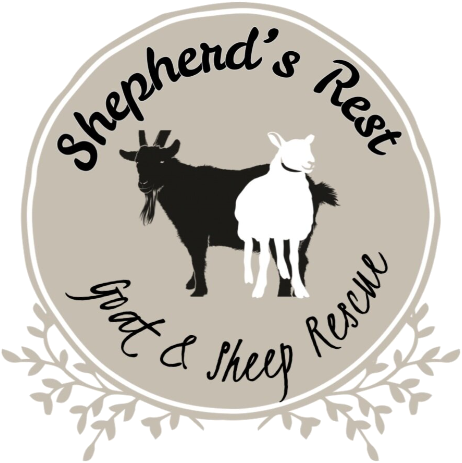Meet the Rescue
Before we can start loading your feed with the latest and greatest Goat of the Month, we’d better start with the basics - who are we here at Shepherd’s Rest?
Rounding the corner near Pickrell, the road stretches along an avenue of native Nebraska prairie to the right, and corn to the left. In the distance, a white house emerges from behind a copse of trees, and upon nearing, goats of all shapes begin to dot the landscape. Juniper trots along on three legs. Sven, a white buck, is wrapped near the waist in a black apron. “He’s in rut,” Jen explains. (That’s “in heat” for non-ruminant mammals.)
Jen Schurman put her heart, mind, and soul behind Shepherd’s Rest Sheep and Goat Rescue. She started caring for goats in 2008. A black-and-white doe– aptly-named “Oreo”– joined her family. Oreo, who was an unintentional breeding by a neighbor, was offered to Jen’s daughter, Sierra as a pet. Upon learning that goats are very social, however, the Schurmans picked up a companion for Oreo from her friend and now goat mentor, Jody Workman. When the companion had a hard time leaving her brother, they took him in too.
“Goats are just as clever as dogs,” says Jen, who has Great Pyrenees on the farm and has been active in Pyr Rescue . “They’re just as sensitive too. They have distinct personalities, and they have quirks.” Those quirks can amplify the already-daunting task of running a rescue. Fences that can help group goats with similar sizes may not be as adept at sorting them by their differences in temperament, and organization is complicated even more by mating season, due to the fact that wethering (neutering) a male goat too early can inhibit the maturing of their urinary tract, which can turn deadly if a goat develops urinary calculi.
But Jen and the team at Shepherd’s Rest find a way. They know their goats like old friends, and the rescue’s expansive grasses and woodlands provide a near-perfect terrain for the playful and peculiar animals. Fencing is one of the primary needs for the rescue.
One of the main principles of the rescue is that goats that have been pets should stay pets, and not become livestock. It’s not that they’re opposed to eating meat; they simply ask goat owners to recognize that their pet has developed relationships with them, and to know that there are alternatives to sending them to market.
In addition to rescue, Shepherd’s Rest hopes to educate people about goats and sheep, and to correct the many misconceptions surrounding them. For example, they challenge the notion that in order to keep dairy goats in milk, they must be kept pregnant constantly. She asserts that a once-a-year pregnancy is enough to continue to produce milk. Continuous breeding is hard on the does and creates a large number of unwanted bucks.
The goats at Shepherd’s Rest rescue give back to their community, too. Putting People and Animals Together in a Way That is Healing for Both is part of the mission statement of Shepherd’s Rest. Jen has brought her rescues in to help residents at area nursing homes, where they are able to break through to patients for whom therapy dogs sometimes can’t. Jen says. “Most people have never seen or interacted with a goat, so it’s the unique feeling of making a connection with something living, that you’ve never connected with before. It changes you.”
Explore the website to learn more about Shepherd’s Rest Sheep and Goat Rescue, or click below to donate.
